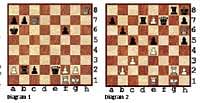Queening doesn't always lead to successful endings on the board
In pawn endings, it is virtually a race for the pawns to reach the last rank and get promoted to queens. Generally the thumb rule is that the pawn queening first has advantage and can easily win the game. However in certain positions even the pawn reaching the last rank first cannot save the situation.
The game below is evenly contested and interestingly both players have passed pawns in the end game stages. It is also a battle between a bishop and knight versus the same with an identical number of pawns. Black manages to reach the queening square first but White smartly checkmates him.
White: Giullo Borgo (2444) – Black; Zoltan Varga (2541)
Budapest, 1999
Alekhine Defence
1.e4 Nf6
The Alekhine defence
2.e5 Nd5 3.d4 d6 4.Nf3 g6 5.Bc4 Nb6 6.Bb3 d5 7.h3
If 7.0–0 Bg7 8.h3 0–0 9.Re1 a5 10.a4 Na6
7...Bg7 8.a4 a5 9.0–0 0–0 10.Re1
If 10.Nc3 Na6 11.Bf4 h6 12.Re1 Bf5 13.Qd2 g5 14.Bg3
10...c6
If 10...Na6 11.Bd2 Nb8 12.Nc3 c6 13.Qe2 Na6 14.Be3 Nc7 15.Qd2 Nc4 16.Bxc4 dxc4 17.Bh6
11.Nc3 Na6 12.Ne2 Nc7 13.c3 Ne6
The knight has travelled a long way to come to this square. If 13...Nc4 14.Bc2 b5 15.b3 Nb6 16.Nf4 bxa4 17.bxa4 Nc4 18.Rb1 f6 19.e6
14.Bc2 f5 15.exf6 (en-passant)
Worth a look is 15.Nf4 Nxf4 16.Bxf4 h6 17.h4 Be6 18.Qd2 and White stands better
15...exf6 16.Nf4
If 16.b3 Re8 17.Qd2 Qd7 18.Ba3 Qf7 19.Ng3 Bd7 20.Re2
16...Qd6 17.Nxe6 Bxe6 18.b3 Rfe8 19.Ba3 [
White should have considered 19.Qd2
19...Qf4
Entering enemy territory
20.Bd3 Bf8 21.Bxf8 Kxf8 22.Qd2 Qxd2
A sudden spate of exchanges
23.Nxd2 Bf7 24.f3
Here White should have seriously considered 24.f4
24...Rxe1+ 25.Rxe1 Re8
Inviting further exchange
26.Rc1
White is not interested! If 26.Rb1 Re3 and Black stands better as he wins a pawn
26...Ke7
If 26.Re3 then the position remains evenly balanced
27.Kf2 Kd6
The Kings have started marching out
28.h4 h6 29.f4 Nc8 30.c4 Ne7
Black would have been better after 30...dxc4 31.bxc4 Kc7
31.Nf1 dxc4 32.bxc4 Kc7 33.Re1 Nc8 34.Rxe8 Bxe8 35.c5 b5
Played rather hastily! If 35...Ne7 36.Ne3 Bf7 37.Bc2 h5 38.g4
36.axb5 cxb5 37.d5 a4
If 37...b4 38.Ke3 a4 39.Nd2 (39.Kd4 a3 40.Nd2) 39...Na7 40.Kd4 a3 41.Bb1 Nb5+ 42.Kc4 Nc3
38.Ke3 a3
This looks like a dangerous advance
39.Bb1 b4 40.Nd2 Bf7
Black should have played 40...Na7
41.Ba2 Kd8 42.Ne4 Ne7
Perhaps better would be 42...f5 43.Nd2 (43.Nf6 Na7) 44.Kd4 Nb5+ 45.Ke5 Nc3) 43...Na7 (43...Ne7 44.Kd4 Bg8 45.Ke5 Nc6+ 46.Kd6 Nd4 47.Bc4) 44.Nf3
43.Nxf6 Nf5+ 44.Ke4 Nxh4 45.Ng4
A good move!
45. .. Nxg2. The Black knight is intent on gobbling up the pawns
46.Ne5 Be8 47.d6
A devastating advance! This has freed the white bishop and also is threatening pawn advances
47. ..h5
A blunder! Black’s position is however critical. He could have offered better resistance with 47. ..Bd7
48.Be6 Bd7
Black is waging a losing battle now!
49.Nxd7 a2
After losing a pieces Black might as well resign but desperately hangs on!
50.c6 a1Q
Diagram 1
51.c7+
Black manages to promote one of his pawns to a queen but still cannot save the game
51. ..Kc8 52.Nc5 checkmate.
Diagram 2
Black to play and win
1. ..Ng3 and it is all over for White.
